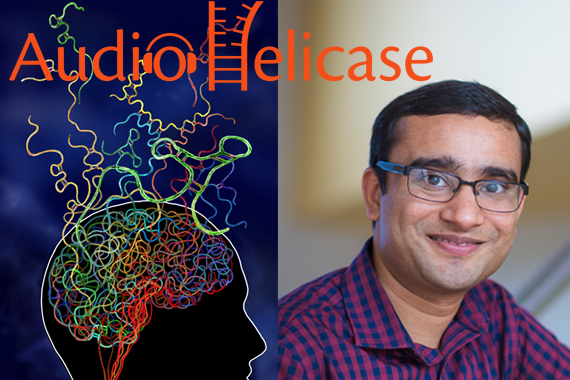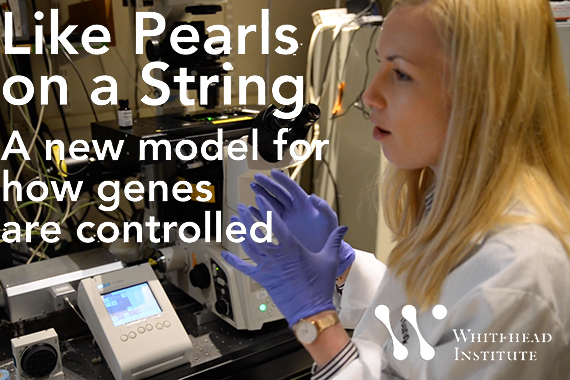
Looking Beyond the Gene: An Introduction
This story is part of our series, Looking Beyond the Gene. Click here to see all stories in this collection.
It's not just the gene — it's how you use it
Some of these regulators have been known for a long time, such as enhancers, DNA sequences that help to increase transcription of certain genes; and transcription factors, proteins that bind to regulatory DNA sequences--including enhancers--and help control transcription rates. However, the full scope of the processes that regulate genes are still being uncovered. To that end, Whitehead researchers are investigating avenues of gene regulation that were previously unknown or not fully understood.
One area of gene regulation that goes “beyond the gene” is epigenetics, in which regulatory information, independent of DNA sequence, can be passed down through generations. Mechanisms can include DNA methylation, in which small chemical tags attach to DNA and by so doing alter the activity of a gene, often silencing it, or alterations of histone proteins, part of the “packing material” that helps compact DNA in the cell nucleus. Epigenetic mechanisms are necessary for embryonic development. Every cell in a developing organism has identical genes, but it is primarily epigenetic cues that enable the cells to differentiate and form distinct tissues by controlling which genes are turned on in which cells and when each gene is activated.
Another pivotal advance has been uncovering the role of RNAs in gene regulation. Once thought to be only transitory intermediaries on the path between DNA and protein, there are in fact many types of RNAs that have key functions in gene regulation. Whitehead researchers and others are also discovering ways in which the architecture of DNA, how folding and bending in the nucleus can create previously unanticipated genetic “neighbors,” affects gene expression.
This linked collection of stories and multimedia pieces delve into Whitehead Institute research in these areas and its implications for health and disease.
The (re)programming of DNA
Epigenetic modification of DNA by methylation usually acts to silence the expression of a gene. Work in Whitehead Institute Founding Member Rudolf Jaenisch’s lab, led by postdoc Shawn Liu, adapted the CRISPR/Cas-9 tool used for editing gene sequences to edit DNA methylation instead. They used this CRISPR tool to remove methylation from the disease gene in neurons with Fragile X syndrome, a common cause of intellectual disability in males. This epigenetic editing effectively returned neurons to normal function in laboratory cell lines transplanted into mice.
Jaenisch’s lab was also one of the first to demonstrate that adult cells, in this case cells from a mouse’s tail, could be coaxed to revert to a stem-cell-like state using a cocktail of factors to epigenetically reprogram them and essentially turn back the clock on the cells’ development. Stem cells created this way, called induced pluripotent stem cells (iPSCs), have expanded the opportunities for exploring cell and tissue development, and allowed researchers to create more accurate research models of disease. Jaenisch helped to establish the viability and value of iPSCs for medical research in experiments investigating sickle cell anemia (led by postdoc Jacob Hanna) and Parkinson’s disease, a neurodegenerative disorder (led by postdoc Marius Wernig). Diseases like Parkinson’s are hard to study on a cellular level because patients’ neurons are not accessible. However, Jaenisch’s lab took cells from patients’ skin, reprogrammed those cells into iPSCs, and then manipulated the cells to develop into neurons that contained the patients’ disease genes and exhibited traits of Parkinson’s disease. The approach of using patient-derived iPSCs to create cells or tissues exhibiting disease traits in the lab has become a common and valuable biomedical research tool.
Whitehead Institute Member Mary Gehring studies epigenetics in plants, focusing on seed development, when epigenetic modifications are most dynamic. Since these modifications are passed down through generations in the wild or in agricultural species, they can have long-lasting effects. One area of her research is imprinting; in the seeds she is studying, certain genes are epigenetically silenced depending on from which parent they were inherited. For example, the copy of a gene received from the plant’s paternal parent might be silenced so that only the maternal version is expressed. Imprinting can affect various aspects of seed development including seed size, an important factor in agriculture.
Gehring also investigates how DNA methylation levels are regulated. Gehring and postdoc Ben Williams discovered that the DNA demethylase gene ROS1 helps to keep methylation levels stable in the cell. They found that ROS1 operates like a thermostat maintaining a certain temperature range: when DNA methylation levels are too high, ROS1 activates and lowers them. The removal of methylation in turn deactivates the gene, keeping the methylation levels relatively stable. Gehring is searching for other mechanisms that provide epigenetic continuity during an organism’s lifetime and across generations.
The importance of staying in shape
Whitehead Institute Member Richard Young investigates how the 3D structure of DNA informs its expression. DNA strands form loops in the cell’s nucleus, cinched closed by proteins, creating what Young refers to as insulated neighborhoods. These loops bring certain genes together in close proximity to DNA sequences called enhancers, which increase transcription of the genes they regulate. This amplifies expression of the genes in the insulated neighborhood. Other genes that are outside of the loop cannot access the enhancers.
Young’s lab discovered that genes essential to cell identity are found in such insulated neighborhoods and, in a project led by former graduate students Abraham Weintraub and Charles Li, identified YY1 as one of the proteins that cinches the loops closed. Young, Weintraub, and postdoc Denes Hnisz also found that mutations that break open loops are common in certain cancers. When the loops are not closed off, cancer genes can gain access to the enhancers inside and may co-opt them to increase their expression and drive cancer progression. Young’s lab is now studying how to identify and possibly fix broken loops as an avenue for cancer therapy.
Regulators stick together
How is it that the proteins needed for gene transcription find the gene they are going to transcribe? The model for how this works has been that these proteins float freely around the cell in large enough numbers that there is a sufficiently high chance that enough will end up in the right place at the right time. However, research from Young and colleagues suggests that the proteins are not free-floating, but rather are corralled near certain genes through a process called phase separation. During phase separation, proteins involved in transcription form droplets within cells, as Young and his lab members describe in this video. These droplets, which Young calls transcriptional condensates, separate from their surroundings like vinegar refusing to mix with oil. Transcriptional condensates compartmentalize and concentrate transcription machinery into a location near the gene being transcribed, potentially streamlining or increasing transcription of the gene.
Condensates can form when molecules involved in transcription, including proteins called transcription factors and coactivators, mesh together. This occurs due to the molecules’ disordered structure: instead of folding into fixed shapes the way most proteins do, transcription factors and coactivators have a malleable end that, like a loose piece of string, easily tangles with others so that groups of the molecules glom together. The existence of transcriptional condensates has important implications for health and disease; the droplets provide possible new targets for example for cancer therapy, since cancer genes may use them to increase their transcription. Understanding the transcription molecules’ environment—inside the droplets versus floating freely through the cell—may provide insights into how to better target them.
Whitehead Institute Member Ankur Jain also investigates phase separation. Instead of proteins, Jain studies phase separated RNA, which he thinks may contribute to some neurodegenerative diseases. Phase separated RNAs not only form droplets, they can condense even further into gels. Jain has found that RNA gels occur in people with repeat expansion disorders, a set of neurodegenerative diseases including Huntington’s disease and ALS, which are caused by excess repetition of short DNA sequences—like CAG or GGGGCC —in the disease gene. The RNA transcribed from the repeated DNA contains the same repeats, making the RNA more likely to stick to itself and other RNAs--the same way a long piece of tape is more likely to tangle and stick to itself than a short one--forming meshes that phase separate into gels. Jain is investigating whether and how these RNA gels may contribute to repeat expansion disorders. He is also investigating whether phase separation of RNA may have functions in healthy cells, the way that transcriptional condensates contribute to normal DNA transcription. Jain discussed his research on Whitehead Institute’s AudioHelicase podcast.
RNA: More than a messenger
Whitehead Institute Member David Bartel studies regulatory RNAs, RNA molecules that can influence gene expression. Bartel’s research has helped to illuminate their important roles in gene regulation. Much of Bartel’s research focuses on microRNAs (miRNA), very small RNA molecules that can repress or silence genes primarily by binding to and degrading messenger RNAs (mRNA), the intermediary molecules between a gene and its protein product. Bartel was the first to describe miRNA in plants, and his research has helped to establish that miRNAs are plentiful across the plant and animal kingdoms. His lab has identified many miRNAs and found evidence that most mammalian genes are targets of miRNAs. According to Bartel, miRNAs play an important role in gene regulation by increasing the granularity of the gene expression spectrum, kind of like a tuner. This allows for more optimal expression levels of a given gene across cell types or at different stages of development. Bartel also investigates other regulatory RNAs and has discovered several types, including heterochromatic siRNAs, which help silence certain regions of DNA. His research contributed to the development of the gene-silencing process known as “RNA interference” or “RNAi” for use as a research tool as well as for treating certain diseases.
Whitehead Institute Fellow Silvia Rouskin investigates how the shape of mRNA can regulate gene expression. According to Rouskin, an RNA can create different proteins based on how it folds, and by so doing control the ultimate output of a gene. Rouskin is investigating this process in the human immunodeficiency virus (HIV). The HIV virus contains a nine-gene long RNA genome that encodes 15 proteins, and, Rouskin says, which of the proteins gets produced may be regulated by the RNA folding itself into various shapes, each of which leads to the expression of a different protein. Rouskin is also investigating this type of regulation in neurodegenerative disease, as well as planning to search for human genes that code for RNAs with this shape-based regulatory ability.
Topics
Contact
Communications and Public Affairs
Phone: 617-452-4630
Email: newsroom@wi.mit.edu






